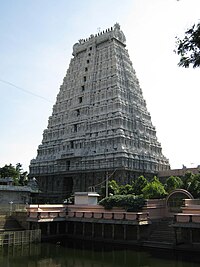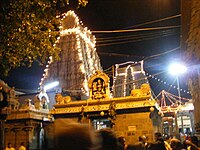Arunachalesvara Temple
| Arunachalesvara Temple | |
|---|---|
Cholas | |
| Completed | 9th century |
| Website | |
| https://annamalaiyar.hrce.tn.gov.in/ | |
Arunachalesvara Temple (also called Annamalaiyar Temple) is a
Shiva is worshipped as Arunachalesvara or Annamalaiyar, and is represented by the
The temple complex covers 10 hectares, and is one of the largest in India.
The present masonry structure was built during the Chola dynasty in the 9th century, while later expansions are attributed to Vijayanagara rulers of the Sangama dynasty (1336–1485 CE), the Saluva dynasty and the Tuluva dynasty (1491–1570 CE). The temple is maintained and administered by the Hindu Religious and Charitable Endowments Department of the Government of Tamil Nadu.
The temple has six daily rituals at various times from 5:30 a.m. to 10 p.m., and twelve yearly festivals on its calendar. The
The western world learnt of Tiruvannamalai during the mid 20th century, through the work of
Legend

In Hindu mythology, Parvati, wife of Shiva, once closed the eyes of her husband playfully in a flower garden at their abode atop Mount Kailash. Although only a moment for the gods, all light was taken from the universe, and the earth, in turn, was submerged in darkness for years. Parvati performed penance along with other devotees of Shiva.[8] Then her husband appeared as a huge column of fire at the top of Annamalai hills, returning light to the world.[9] He then merged with Parvati to form Ardhanarishvara, the half-female, half-male form of Shiva.[10] The Arunachala, or red mountain, lies behind the Arunachalesvara temple, and is associated with the temple of its namesake.[3] The hill itself is sacred and considered a lingam, or an iconic representation of Shiva.[11]
Another legend is that once, while Vishnu and Brahma contested for superiority, Shiva appeared as a flame, and challenged them to find his source.[12][13] Brahma took the form of a swan, and flew to the sky to see the top of the flame, while Vishnu became the boar Varaha, and sought its base.[12] The scene is called Lingodbhava, and is represented in the western wall at the sanctum of most Shiva temples.[12] Neither Brahma nor Vishnu could find the source even.[12]
History

Ancient Tamil scholars such as Nakkirar (1st century BCE–1st century CE),
During the 17th century CE, the temple along with the Tiruvannamalai town came under the dominion of the
Architecture

Complex and towers

The temple is situated at the bottom of the Arunachala hills, and faces east, lying over 10 hectares (25 acres). The walls on the east and west measure 210 metres (700 ft), the south 451 metres (1,479 ft), and the north 480 metres (1,590 ft). The present masonry and towers date back to the 9th century CE, as seen from an inscription in the structure made by
Shrines
The main shrine of Arunachalesvara faces east, housing images of Nandi and
Halls

There is a sixteen-pillared Deepa Darshana Mandapam, or hall of light, in the third precinct. The temple tree, Magizha, is considered sacred and medicinal, and childless couples tie small cradles to its branches in obeisance. Vedas write that the mast of the temple separated the earth and the sky during creation of the universe.[32] The Kalyana Mandapam, the marriage hall, is in the south-west of the precinct, and is built in Vijayanagara style. A stone trident is present in the outer shrine of the temple in open air, and has protective railings like a sacred tree.[33] The Vasantha Mandapam, meaning the Hall of spring, is the third precinct, and contains the temple office and Kalahateeswarar shrine.[34] The fourth precinct has an image of Nandi, Brahma Theertham, the temple tank, the Yanai Thirai Konda Vinayaga shrine, and a hall with a 1.8-metre (6 ft)-tall statue of Nandi, erected by Vallala Maharaja.[29]
Inside the doorway of the first tower and the fifth precinct, there is a thousand-pillared hall built during the late
Worship and festivals
The temple priests perform the
The temple celebrates dozens of festivals throughout the year.

Every full moon, tens of thousands of pilgrims worship Arunachalesvara by circumambulating the Arunachala hill barefoot.[5] The circumambulation covers a distance of 14 kilometres (8.7 mi), and is referred to as Girivalam.[6][40] According to Hindu legend, the walk removes sins, fulfils desires and helps achieve freedom from the cycle of birth and rebirth.[15] Offerings are made in a string of tanks, shrines, pillared meditation halls, springs and caves around the hill.[3] The circumambulation continues during the rest of the month. On the day of yearly Chitra Pournami, the full moon of the Tamil calendar, hundreds of thousands of pilgrims come from across the world to worship Arunachalesvara. Five temple cars, called ther, with wooden carvings, are used for the procession.[15]
Tiruvoodal is another festival celebrated during the first week of the Tamil month Thai at mid-January of every year. On the morning of Maatu Pongal, between 15 and 16 January,
Religious significance
The Arunachalesvara temple is one of the
Aathara Stala are Shiva temples which are considered to be personifications of the Tantric chakras of human anatomy. The Arunachalesvara temple is called the Manipooraga stalam,[34] and is associated with the Manipooraga (Manipura) chakra. Manipooraga is the chakra associated with the solar plexus.[44]
Saints and literary mention
The western world learnt of Tiruvannamalai during the mid 20th century, through the work of
See also
Notes
- ISBN 9781610690263. Retrieved 26 February 2019.
- ^ a b c Singh et al. 2009, p. 418.
- ^ a b c Abram et al. 2011, p. 456.
- ^ a b c Bajwa & Kaur 2008, p. 1069.
- ^ a b c d e f g Bradnock & Bradnock 2009, pp. 827–828.
- ^ a b Tiruvannamalai - Places of interest 2011.
- ^ a b Melton 2002.
- ^ V. 1974, p. 42.
- ^ a b c Hunter 1908, pp. 129–130.
- ^ Kingsbury & Phillips 1921, p. 13.
- ^ Goodman 2002, pp. 38–39.
- ^ a b c d Aiyar 1982, pp. 190–191.
- ^ a b c d History of Tiruvannamalai 2011.
- ^ a b "Arunachala, A Short History of Hill and Temple". Archived from the original on 23 January 2022.
- ^ a b c d e f Arunachaleswarar Thirukoil 2012.
- ^ a b c d e Aiyar 1982, pp. 191–203.
- ^ Aiyangar 1991, p. 174.
- ^ Mack 2002, p. 82.
- ^ a b c Mack 2002, pp. 88–90.
- ^ Mack 2002, p. 81.
- ^ a b Mack 2002, pp. 71–72.
- ^ Tiruvannamalai - About the town 2011.
- ^ Gaur 2006, p. 126.
- ^ HR&CE website.
- ^ Southern Circle 1903, p. 5.
- ^ V. 1995, p. ii.
- ^ a b c V. 1995, p. 31.
- ^ a b c Mack 2002, pp. 72–74.
- ^ a b c Nārāyaṇasvāmi 1992, p. 24.
- ^ a b Various 2006, p. 79.
- ^ a b Ebert 2006, pp. 35–46.
- ^ Elgood 1999, p. 23.
- ^ Elgood 1999, p. 48.
- ^ a b c Kamalabaskaran 1994.
- ^ Aiyar 1982, p. 546.
- ^ Let's Go, Inc 2004, p. 615.
- ^ a b Arunachalesvara Temple rituals.
- ^ Mack 2002, pp. 72–73.
- ^ The Hindu & 14 December 2005.
- ^ Tiruvannamalai temple - Girivalam 2011.
- ^ Anantharaman 2006, p. 28.
- ^ Ramaswamy 2007, pp. 301–302.
- ^ Blavatsky 1892, p. 189.
- ^ Spear 2011.
- ^ Tirugnanasambadar 2004, pp. 27–28.
- ^ Appar 2004, pp. 8–11.
- ^ Muthalam Thirumurai Translation 2012.
- ^ Pope 2004, p. 150.
- ^ The Hindu & 21 June 2002.
- ^ V.K. 2007, p. 109.
- ^ Zvelebil 1975, p. 217.
- ^ a b Abram et al. 2011, p. 972.
References
- "Hindu Religious and Endowment Board". Hindu Religious and Endowment Board. 2011. Retrieved 27 December 2012.
- "Arunachalesvara Temple rituals". Arunachalesvara Temple. 2011. Archived from the original on 12 December 2011. Retrieved 27 December 2012.
- "Tiruvannamalai - About the town". Tiruvannamalai Municipality. 2011. Archived from the original on 25 January 2013. Retrieved 6 September 2012.
- "Tiruvannamalai - Places of interest". Tiruvannamalai Municipality. 2011. Archived from the original on 24 August 2013. Retrieved 6 September 2012.
- "Tiruvannamali Historical moments". Tiruvannamalai Municipality. 2011. Archived from the original on 29 October 2013. Retrieved 6 September 2012.
- "Tiruvannamalai temple - Girivalam details". Tiruvannamalai Temple Administration. 2011. Archived from the original on 29 August 2012. Retrieved 6 September 2012.
- "Muthalam Thirumurai Translation". Thevaaram.org. 2012. Retrieved 6 September 2012.
- "Arunachaleswarar Thirukoil". Government of Tamil Nadu. 2012. Archived from the original on 24 September 2011. Retrieved 6 September 2012.
- "10 lakh devotees witness Tiruvannamalai Deepam". The Hindu. 2005. Archived from the original on 19 February 2006. Retrieved 6 September 2012.
- "Fire that stokes up faith". The Hindu. 2002. Archived from the original on 27 June 2003. Retrieved 6 September 2012.
- Aiyar, P.V.Jagadisa (1982), South Indian Shrines: Illustrated, New Delhi: Asian Educational Services, ISBN 81-206-0151-3.
- Abram, David; Edwards, Nick; Ford, Mike; Jacobs, Daniel; Meghji, Shafik; Sen, Devdan; Thomas, Gavin (2011), The Rough guide to India, Rough Guides, ISBN 978-1-84836-563-6.
- Appar (2004), Aintham Thirumurai (PDF), Online: project Madurai.
- Aiyangar, Krishnaswami S. (1991), South India and Her Muhammadan Invaders, New Delhi: Asian Educational Services, ISBN 81-206-0536-5.
- Anantharaman, Ambujam (2006). Temples of South India. East West books. ISBN 8188661422.
- Bajwa, Jagir Singh; Kaur, Ravinder (2008), Tourism Management, New Delhi: S.B. Nangia, ISBN 978-81-313-0047-3.
- Blavatsky, Helena Petrovna (1892), The theosophical glossary, London: The Theosophical Publishing Society.
- Bradnock, Roma; Bradnock, Robert (2009), Footprint India, USA: Patrick Dawson, ISBN 978-1-904777-00-7.
- Ebert, Gabriele (2006), Ramana Maharshi: His Life, Lulu.com, ].
- Elgood, Heather (1999), Hinduism and the Religious Arts, New York: British Library Cataloguing-in-Publication Data, ISBN 0-304-70739-2.
- Goodman, Martin (2002), On Sacred Mountains, UK: Heart of Albion Press, ISBN 1-872883-58-3.
- Gaur, Mahendra (2006), Indian affairs annual, Delhi: Kalpaz Publications, ISBN 81-7835-529-9.
- Hunter, Sir William (1908), Imperial gazetteer of India: Provincial series, Volume 18, Calcutta: Superintendent of Government Printing.
- Kamalabaskaran, Iswari (1994), The light of Arunachaleswarar, Affiliated East-West Press Pvt. Ltd..
- Kingsbury, Francis; Phillips, Godfrey Edward (1921), Hymns of the Tamil Śaivite saints, New York: Bishop of Dornakal.
- Let's Go, Inc (2004), Let's go: India & Nepal, 2004, New York: Martin's Press, ISBN 0-312-32006-X.
- Mack, Alexander (2002), Spiritual journey, imperial city: pilgrimage to the temples of Vijayanagara, New Delhi: Vedam e-books Pvt. Ltd., ISBN 81-7936-004-0.
- Melton, J. Gordon (2002), The Encyclopedia of Religious Phenomena, MI: Visible Ink Press, ISBN 1-57859-209-7.
- Nārāyaṇasvāmi, Veṅkaṭarāma (1992), Thiruvannamalai, Madras: Manivasagar Noolagam.
- Pope, Rev. G.U. (2004), Tiruvacagam or Sacred Utterances of the Tamil Poet, Saint and Sage (PDF), Online: project Madurai.
- Ramaswamy, Vijaya (2007), Historical dictionary of the Tamils, United States: Scarecrow Press, INC., ISBN 978-0-470-82958-5
- Singh, Sarina; Brown, Lindsay; Elliott, Mark; Harding, Paul; Hole, Abigail; Horton, Patrick (2009), Lonely Planet India, Australia: Lonely Planet, ISBN 978-1-74179-151-8.
- Southern Circle (1903), Epigraphy, Madras: Archaeological Survey of India.
- Spear, Heidi (2011), The Everything Guide to Chakra Healing: Use Your Body's Subtle Energies to promote Health, Healing and Happiness, USA: Adams Media, ISBN 978-1-4405-2649-7.
- Tirugnanasambadar (2004), Muthal Thirumurai (PDF), Online: project Madurai.
- V., Meena (1974). Temples in South India (1st ed.). Kanniyakumari: Harikumar Arts.
- V., Vriddhagirisan (1995), Nayaks of Tanjore, New Delhi: Asian Educational Services, ISBN 81-206-0996-4.
- V.K., Subramanian (2007), 101 Mystics of India, New Delhi: Abhinav Publications, ISBN 978-81-7017-471-4.
- Various (2006), Tourist Guide to South India, New Delhi: Sura Books (pvt) Ltd., ISBN 81-7478-175-7.
- Zvelebil, Kamil (1975), Tamil literature, Volume 2, Part 1, Netherlands: E.J. Brill, Leiden, ISBN 90-04-04190-7.
External links
- Temple Official website Archived 6 November 2021 at the Wayback Machine




